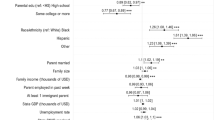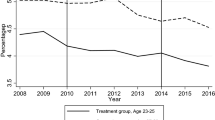Abstract
Subpopulations have variable connections to specific institutions, such as the military, which can influence their use of social programs and access to resources. We use data from the 5-year (2008–2012) American Community Survey (ACS) public-use file to examine current Supplemental Nutrition Assistance Program (SNAP) use by military service status: active-duty personnel, recent veterans, long-term veterans, and reserve/guard members. Overall and by military service status, we estimate weighted descriptive statistics and multivariate logistic regression models that include demographic and socioeconomic controls. We document low but non-trivial levels of participation among active-duty personnel (2.2 %), higher but still moderate levels of SNAP use among veterans (7.1 % for recent veterans and 6.5 % for long-term veterans), and the highest level of use among members of the reserve/guard (9.0 %). Multivariate analyses support hypotheses based on the potential for the military, as a total institution, to substantially reduce use of SNAP among active-duty personnel, while veterans and reservists, who are more distal from food-related institutional resources, have higher likelihoods of using SNAP. Although levels of SNAP use among active-duty personnel, veterans, and reservists are lower than those observed in the national population, which includes those with no direct connection to military institutions, findings suggest that leaving active-duty military service results in a substantial and relatively immediate reduction in food-related resources for many recent veterans and their families. We discuss the implications of the findings for policy, limitations of the research, and directions for future research.
Similar content being viewed by others
Notes
Among those living below 185 % of the poverty threshold, 84.3 % were long-term veterans, 11.1 % were reservists, 2.3 % were on active duty, and 2.3 % were recent veterans.
Among those below 185 % of the poverty threshold, 21.9 % used SNAP, with substantial variation in rates of use across the military service subsamples: 6.1 % among active-duty personnel, 19.1 % among recent veterans, 21.4 % among long-term veterans, and 29.6 % among members of the reserve/guard.
Among those below 185 % of poverty, we find similar results: the odds ratios are 0.17 for the active-duty, 0.48 for the recent veterans, and 0.85 for the long-term veterans, and they are all statistically significantly different from the reserve/guard and from one another.
References
Blank, R., & Haskins, R. (2002). The new world of welfare. Washington, DC: Brookings Institution.
Burland, D., & Lundquist, J. H. (2013). The best years of our lives: Military service and family relationships—A life-course perspective. In J. M. Wilmoth & A. S. London (Eds.), Life-course perspectives on military service (pp. 163–184). New York: Routledge.
Center, Military Family Resource. (2000). Military families in the millennium. Arlington, VA: MFRC.
Clever, M., & Segal, D. R. (2013). The demographics of military children and families. The Future of Children, 23(2), 13–39.
Coleman-Jensen, A., Nord, M., & Singh, A. (2013). Household food security in the United States in 2012. Economic research report No. 155. Washington, DC: USDA, Economic Research Service. Retrieved September 2, 2014, from http://www.ers.usda.gov/media/1183208/err-155.pdf.
Curtis, K. J., & Payne, C. F. (2010). The differential impact of mortality of American troops in the Iraq War: The non-metropolitan dimension. Demographic Research, 23, 41–62.
DeNavas-Walt, C., Proctor, B.D., & Smith J.C. (2013). Income, poverty, and health insurance coverage in the United States: 2012. Current Population Reports, P60-245. Washington, DC: U.S. Government Printing Office. Retrieved September 2, 2014, from http://www.census.gov/prod/2013pubs/p60-245.pdf.
Eslami, E., Filion, K., & Strayer, M. (2011). Characteristics of Supplemental Nutrition Assistance Program households: Fiscal year 2010. Alexandria, VA: USDA Food and Nutrition Service Office of Research and Analysis.
Farson, K. F., & Eslami, E. (2014). Characteristics of Supplemental Nutrition Assistance Program households: Fiscal year 2012. Alexandria, VA: U.S. Department of Agriculture, Food and Nutrition Service, Office of Policy Support. Retrieved September 2, 2014, from http://www.fns.usda.gov/sites/default/files/2012Characteristics.pdf.
Food Research and Action Center. (2014). #Who goes hungry? Retrieved September 12, 2014, from http://whogoeshungry.org/.
Ganong, P., & Liebman, J. (2013). Explaining trends in SNAP enrollment. Mimeo, Harvard University. Retrieved September 12, 2014, from http://www.studymode.com/essays/Explaining-Trends-In-Snap-Enrollment-1827298.html.
Gill, H. L., Haurin, D. R., & Phillips, J. (1994). Mobility and fertility in the military. Social Science Quarterly, 75(2), 340–353.
Greenberg Quinlan Rosner Research and Public Opinion Strategies. (2012). A new generation of leaders: A report on America’s perceptions of Iraq and Afghanistan veterans. St. Louis, MO: The Mission Continues. Retrieved September 12, 2014, from https://www.google.com/search?q=A+New+Generation+of+Leaders%3A+A+Report+on+America%E2%80%99s+Perceptions+of+Iraq+and+Afghanistan+Veterans&ie=utf-8&oe=utf-8&aq=t&rls=org.mozilla:en-US:official&client=firefox-a&channel=sb.
Heflin, C. M., London, A. S., & Scott, E. K. (2011). Mitigating material hardship: The strategies low-income families employ to reduce the consequences of poverty. Sociological Inquiry, 81(2), 223–246.
Heflin, C. M., Wilmoth, J. M., & London, A. S. (2012). Veteran status and material hardship: The moderating influence of disability. Social Service Review, 86(1), 119–142.
Ingram, H., Schneider, A. I., & deLeon, P. (2007). Social construction and policy design. In P. A. Sebatier (Ed.), Theories of the policy process (2nd ed., pp. 93–126). Boulder, CO: Westview.
Isaacs, J. B., & Healy, O. (2012). The recession’s ongoing impact on children, 2012: Indicators of children’s economic well-being. Washington, DC: Urban Institute. Retrieved September 12, 2014, from http://www.urban.org/UploadedPDF/412713-The-Recessions-Ongoing-Impact-on-Children-2012.pdf.
Klerman, J., & Danielson, C. (2011). The transformation of the Supplemental Nutrition Assistance Program. Journal of Policy Analysis and Management, 30(4), 863–888.
Kleykamp, M. (2013). Labor market outcomes among veterans and military spouses. In J. M. Wilmoth & A. S. London (Eds.), Life-course perspectives on military service (pp. 144–164). New York: Routledge.
London, A. S., Heflin, C. M., & Wilmoth, J. M. (2011). Work-related disability, veteran status, and poverty: Implications for family well-being. Journal of Poverty, 15(3), 330–349.
Lundquist, J. H., & Smith, H. L. (2005). Family formation among women in the U.S. military: Evidence from the NLSY. Journal of Marriage and Family, 67(1), 1–13.
McCain, J. (2000). McCain unveils bill to eliminate ‘Food Stamp Army’. Retrieved May 2, 2015, from http://www.mccain.senate.gov/public/index.cfm/2000/3/post-e367045d-4b5f-41fe-b985-a548f1797fdc.
Meyer, B. D., & Goerge, R. (2011). Errors in survey reporting and imputation and their effects on estimates of Food Stamp Program participation. Paper No. CES-WP-11-14. Washington, DC: U.S. Census Bureau Center for Economic Studies. Retrieved September 12, 2014, from http://dx.doi.org/10.2139/ssrn.1824261.
Moffitt, R. A. (2013). The Great Recession and the social safety net. The Annals of the American Academy of Political and Social Science, 650(1), 143–166.
Nord, M. (2011). How much does the Supplemental Nutrition Assistance Program alleviate food insecurity? Evidence from recent programme leavers. Public Health Nutrition, 15(5), 811–817.
Nord, M., & Prell, M. (2011). Food security improved following the 2009 ARRA increase in SNAP benefits. Paper No. ERR-116. Washington, DC: USDA, Economic Research Service. Retrieved September 12, 2014, from http://www.ers.usda.gov/publications/err-economic-research-report/err116.aspx#.VBMY-WMemSo.
Parker, K. (2012). Where the public stands on government assistance, taxes, and the presidential candidates. Retrieved September 12, 2014, from http://www.pewsocialtrends.org/2012/09/20/where-the-public-stands-on-government-assistance-taxes-and-the-presidential-candidates/.
Pilkauskas, N. V., Currie, J., & Garfinkel, I. (2012). The Great Recession, public transfers, and material hardship. The Social Service Review, 86(3), 401–427.
Ruggles, S., Trent, A. J., Genadek, K., Goeken, R., Schroeder, M. B., & Sobek, M. (2010). Integrated public use microdata series: Version 5.0 [machine-readable database]. Minneapolis, MN: University of Minnesota.
Slack, T., & Myers, C. A. (2014). The Great Recession and the changing geography of Food Stamp receipt. Population Research and Policy Review, 33, 63–79.
State Health Access Data Assistance Center. (2013). Accuracy of Medicaid reporting in the ACS: Preliminary results from linked data. Minneapolis, MN: University of Minnesota.
Teachman, J. (2007). Race, military service, and marital timing: Evidence from the NLSY79. Demography, 44(2), 389–404.
Tiehen, L., Jolliffe, D., & Gundersen, C. (2012). Alleviating poverty in the United States: The critical role of SNAP benefits. Washington, DC: USDA, Economic Research Service. Retrieved September 12, 2014, from http://www.ers.usda.gov/publications/err-economic-research-report/err132.aspx#.VBMb1WMemSo.
Tiehen, L., Jolliffe, D., & Smeeding, T. (2013). The effect of SNAP on poverty. Paper presented at the UKCPR-IRP conference five decades of Food Stamps, Washington, DC, September 20. Retrieved September 12, 2014, from http://www.google.com/url?sa=t&rct=j&q=&esrc=s&source=web&cd=1&ved=0CCAQFjAA&url=http%3A%2F%2Fwww.irp.wisc.edu%2Fpublications%2Fdps%2Fpdfs%2Fdp141513.pdf&ei=cxwTVObLNpWoyATXy4KIBA&usg=AFQjCNGPLwjRLky_EW_wuw-QaE8Pp2cnRg&sig2=b9sAzSR37xSRr19f7L7MVQ&bvm=bv.75097201,d.aWw.
U.S. Census Bureau. (2013). Profile America: Facts for features. Washington, D.C.: U.S. Department of Commerce.
U.S. Department of Agriculture (USDA). (2014). Supplemental Nutrition Assistance Program: Average monthly participation (Persons). Updated July 11, 2014, from http://www.fns.usda.gov/pd/supplemental-nutrition-assistance-program-snap
Widome, R., Jensen, A., Bangerter, A., & Fu, S. S. (2014). Food insecurity among veterans of the U.S. wars in Iraq and Afghanistan. Public Health. doi:10.1017/S136898001400072X.
Wilmoth, J. M., & London, A. S. (2011). Aging veterans: Needs and provisions. In R. A. Settersten, Jr. & J. L. Angel (Eds.), Handbook of Sociology of Aging (pp. 445–461). New York: Springer.
Wilmoth, J. M., London, A. S., & Heflin, C. M. (2015). Economic well-being among older-adult households: Variation by veteran and disability status. Journal of Gerontological Social Work, 58(4), 399–419.
Wolf, D. A., Wing, C., & Lopoo, L. M. (2013). Methodological problems in determining the consequences of military service. In J. M. Wilmoth & A. S. London (Eds.), Life-course perspectives on military service (pp. 254–274). New York: Routledge.
Ziliak, J. P. (2013). Who uses SNAP, and when? The role of the economy, policy, and demographics. Paper presented at the UKCPR-IRP conference Five Decades of Food Stamps, Washington, DC, September 20. Retrieved September 12, 2014, from http://www.google.com/url?sa=t&rct=j&q=&esrc=s&source=web&cd=2&ved=0CCcQFjAB&url=http%3A%2F%2Fgatton.uky.edu%2FUnits%2FDownloads%2FZiliak_SNAP_Conferencedraft.pdf&ei=0DkTVIzdPJGeyASWp4C4Ag&usg=AFQjCNFAFjy3PvSSirXql7x2zoYNGEYnwQ&sig2=isUwGFQ2xiq7hD_TN-LS1g&bvm=bv.75097201,d.aWw.
Author information
Authors and Affiliations
Corresponding author
Rights and permissions
About this article
Cite this article
London, A.S., Heflin, C.M. Supplemental Nutrition Assistance Program (SNAP) Use Among Active-Duty Military Personnel, Veterans, and Reservists. Popul Res Policy Rev 34, 805–826 (2015). https://doi.org/10.1007/s11113-015-9373-x
Received:
Accepted:
Published:
Issue Date:
DOI: https://doi.org/10.1007/s11113-015-9373-x




